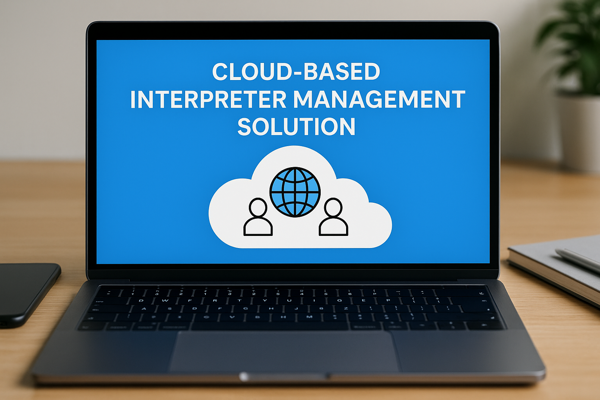Can Interpreter IO Help Forecast Interpreter Demand?

Missed appointments, overworked interpreters, and wasted time slots are the hidden costs of relying on spreadsheets, phone calls, or guesswork to manage interpreter demand.
Hospitals see sudden spikes in emergency requests, courts face last-minute calls for certified interpreters, and schools scramble to cover dozens of languages during parent-teacher meetings. Without accurate forecasting, organizations lose time, revenue, and client trust.
Interpreter scheduling is no longer just about filling appointments, it’s about being prepared. Demand fluctuates by language, time of day, and even season, and manual methods simply can’t keep up.
To stay ahead, organizations need a smarter, data-driven way to predict when and where interpreters will be needed. Modern interpreter management platforms, like Interpreter IO, make this possible by combining seamless scheduling with powerful forecasting tools.
Why Forecasting Interpreter Demand Matters
1. Meeting Client Needs on Time
When demand spikes unexpectedly, say during flu season in hospitals or peak trial sessions in courts, organizations need enough interpreters available to respond immediately. Without accurate forecasting, clients may face delays or lack access to language services.
2. Avoiding Overstaffing and Understaffing
Too few interpreters leads to missed appointments and frustrated clients. Too many sitting idle drives up unnecessary costs. Forecasting helps balance resources and ensure the right number of interpreters are scheduled.
3. Planning for Rare and High-Demand Languages
Not all languages are requested equally. Some may see sudden spikes due to refugee arrivals, international events, or changing demographics. Forecasting tools allow organizations to prepare ahead and ensure rare language interpreters are on call.
4. Strengthening Interpreter Retention
Overworked interpreters are more likely to leave. By forecasting demand properly, organizations can distribute assignments fairly, avoid burnout, and improve interpreter satisfaction.
The Limitations of Manual Forecasting
Many organizations still try to predict demand using manual spreadsheets, phone logs, or gut instinct. This approach creates several problems:
- Limited data visibility: Manual tracking doesn’t show real trends across languages or sectors.
- Reactive, not proactive: Decisions are often made after shortages or no-shows occur.
- Time-consuming: Staff spend hours analysing outdated data that may not reflect current realities.
- Inaccurate outcomes: Without real-time analytics, manual forecasting often results in errors.
Manual forecasting may have worked in the past, but today’s fast-paced, multilingual environment demands data-driven accuracy.
How Interpreter IO Helps Forecast Interpreter Demand

Interpreter IO is more than just a scheduling tool, it’s a cloud-based interpreter management solution with powerful reporting and analytics features. Here’s how it helps organizations forecast demand more effectively:
1. Real-Time Data Collection
Every booking, cancellation, interpreter assignment, and service request is tracked in real time. This data provides a clear picture of demand patterns across:
- Languages.
- Service types (onsite, phone, video).
- Locations.
- Times of day and days of the week.
2. Analytics Dashboards
Interpreter IO includes easy-to-read dashboards that transform raw data into actionable insights. Managers can see which languages are most requested, when peak times occur, and how interpreters are being utilized.
3. Demand Forecasting Tools
By analyzing historical trends, Interpreter IO can help predict future needs. For example:
- A hospital may identify that Spanish interpreters are in highest demand on Mondays and Fridays.
- A court system may notice increased demand for certain languages during specific trial sessions.
- A school district may forecast increased interpreter needs at the start of each academic year.
4. Workforce Planning
With forecasting insights, administrators can:
- Recruit interpreters for high-demand languages.
- Adjust staffing levels during peak times.
- Create on-call pools for emergencies.
- Reduce overtime costs by balancing workloads fairly.
5. Integration with Scheduling
Forecasting is most effective when it’s directly tied to scheduling. Interpreter IO links data insights to its automated scheduling engine, ensuring that demand forecasts are not just numbers but actionable solutions.
Example: Forecasting in Healthcare
A regional hospital system used to experience major gaps in interpreter coverage, particularly in the emergency department. Administrators guessed demand but often underestimated the number of interpreters required on weekends.
By switching to Interpreter IO, the hospital was able to:
- Track real-time usage of phone and video interpreting.
- Identify that Arabic and Mandarin requests spiked between 6–10 p.m. on Fridays.
- Adjust staffing accordingly, reducing patient wait times by 40%.
The result? Better patient outcomes, reduced staff stress, and more efficient interpreter use.
Example: Forecasting in Courts
A large court system struggled with sudden surges in interpreter demand during high-profile cases. Without clear visibility, schedulers often scrambled to find certified interpreters at the last minute.
Interpreter IO’s forecasting tools allowed the courts to:
- Analyze language demand by case type.
- Anticipate increased requests during trial periods.
- Build a pre-approved roster of interpreters to cover demand.
This reduced last-minute cancellations and improved compliance with legal requirements.
How Forecasting Improves Interpreter ROI
Forecasting with Interpreter IO is not just about convenience, it has a direct financial impact.
- Reduced no-shows: Accurate planning lowers missed appointments.
- Lower admin costs: Less time spent manually analysing data.
- Optimised resource use: Better balance between full-time, part-time, and freelance interpreters.
- Revenue capture: Fewer lost opportunities from unfilled bookings.
The result is a more cost-effective interpreting service that scales with demand.
Interpreter IO vs Other Platforms
While many interpreter platforms offer scheduling, few provide robust forecasting tools. Interpreter IO sets itself apart with:
- Real-time reporting (most competitors provide only static summaries).
- Sector-specific insights (healthcare, legal, education).
- Integrated forecasting and scheduling in one platform.
- Interpreter-friendly portals that improve communication and engagement.
This combination of forecasting power and usability makes Interpreter IO a leader in helping organizations stay ahead of demand.
The Future of Interpreter Demand Forecasting
As the industry evolves, forecasting will only become more essential. Key future trends include:
- AI-powered predictions that analyse not just past data but external factors (population shifts, migration trends, health events).
- Deeper integrations with government and institutional databases for proactive planning.
- Dynamic scheduling that automatically adjusts as forecasts shift in real time.
Interpreter IO is already aligning with these innovations, ensuring organizations are prepared not just for today’s challenges but for tomorrow’s.
Ready to Forecast Interpreter Demand More Accurately?
Forecasting interpreter demand is no longer a “nice to have”, it’s a necessity for efficient, compliant, and cost-effective service delivery. Manual methods can’t keep up with the complexity of today’s multilingual world.
Interpreter IO gives you the tools to predict, plan, and perform better. From real-time analytics to smart scheduling integrations, our platform helps you anticipate demand and ensure interpreters are always where they’re needed most.
Book a Demo with Interpreter IO today to see how forecasting can transform your interpreting services.
